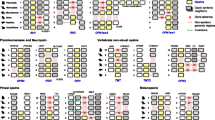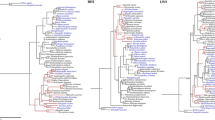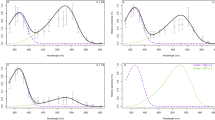Abstract
Ultraviolet (UV) vision exists in several animal groups. Intuitively, one would expect this trait to be favoured in species living in bright environments, where UV light is the most present. However, UV sensitivity, as deduced from sequences of UV photoreceptors and/or ocular media transmittance, is also present in nocturnal species, raising questions about the selective pressure maintaining this perceptual ability. Amphibians are among the most nocturnal vertebrates but their visual ecology remains poorly understood relative to other groups. Perhaps because many of these species breed in environments that filter out a large part of UV radiation, physiological and behavioural studies of UV sensitivity in this group are scarce. We investigated the extent of UV vision in Caudata, the order of amphibians with the most nocturnal habits. We could recover sequences of the UV sensitive SWS1 opsin in 40 out of 58 species, belonging to 6 families. In all of these species, the evidence suggests the presence of functional SWS1 opsins under purifying selection, potentially allowing UV vision. Interestingly, most species whose opsin genes failed to amplify exhibited particular ecological features that could drive the loss of UV vision. This likely wide distribution of functional UV photoreceptors in Caudata sheds a new light on the visual ecology of amphibians and questions the function of UV vision in nocturnal animal species.


Similar content being viewed by others

References
Bennet, A. T. D., Cuthill, I. C., Partridge, J. C., & Maier, E. J. (1996). Ultraviolet vision and mate choice in zebra finches. Nature, 380, 433–435.
Blaustein, A. R., Kiesecker, J. M., Chivers, D. P., & Anthony, R. G. (1997). Ambient UV-B radiation causes deformities in amphibian embryos. Proceedings of the National Academy of Sciences USA, 94, 13735–13737.
Bowmaker, J. K. (2008). Evolution of vertebrate visual pigments. Vision Research, 48, 2022–2041.
Briscoe, A. D., & Chittka, L. (2001). The evolution of color vision in insects. Annual Review of Entomology, 46, 471–510.
Carvalho, L. D. S., Cowing, J. A., Wilkie, S. E., Bowmaker, J. K., & Hunt, D. M. (2006). Shortwave visual sensitivity in tree and flying squirrels reflects changes in lifestyle. Current Biology, 16, R81–R83.
Carvalho, L. S., Davies, W. L., Robinson, P. R., & Hunt, D. M. (2012). Spectral tuning and evolution of primate short-wavelength-sensitive visual pigments. Proceedings of the Royal Society London B, 279, 387–393.
Collin, S. P., Knight, M. A., Davies, W. L., Potter, I. C., Hunt, D. M., & Trezise, A. E. O. (2003). Ancient colour vision: multiple opsin genes in the ancestral vertebrates. Current Biology, 13, R864–R865.
Crump, D., Lean, D., Berrill, M., Coulson, D., & Toy, L. (1999). Spectral irradiance in pond water: influence of water chemistry. Photochemistry and Photobiology, 70, 893–901.
Davies, W. I. L., Collin, S. P., & Hunt, D. M. (2012). Molecular ecology and adaptation of visual photopigments in craniates. Molecular Ecology, 21(13), 3121–3158.
Delport, W., Poon, A. F., Frost, S. D., & Pond, S. L. K. (2010). Datamonkey 2010: A suite of phylogenetic analysis tools for evolutionary biology. Bioinformatics, 26, 2455–2457.
Deutschlander, M. E., & Phillips, J. B. (1995). Characterization of an ultraviolet photoreceptor mechanism in the retina of an amphibian, the axolotl (Ambystoma mexicanum). Neuroscience Letters, 197, 93–96.
Dietz, M. (1972). Erdkröten können UV-Licht sehen. Naturwissenschaften, 59, 316.
Douglas, R. H., & Jeffery, G. (2014). The spectral transmission of ocular media suggests ultraviolet sensitivity is widespread among mammals. Proceedings of the Royal Society of London B: Biological Sciences, 281, 20132995.
Edrich, W. (1979). Honey bees: Photoreceptors participating in orientation behaviour to light and gravity. Journal of Comparative Physiology A, 133, 111–116.
Endler, J. A. (1993). The color of light in forests and its implications. Ecological Monographs, 63, 2–27.
Eugene, J. C., & Buchmann, S. L. (1974). Ultraviolet floral patterns as functional orientation cues in hymenopterous pollination systems. Animal Behaviour, 22, 481–485.
Govardovskii, V. I., & Zueva, L. V. (1974). Spectral sensitivity of the frog eye in the ultraviolet and visible region. Vision Research, 14, 1317–1321.
Hall, T. A. (1999). BioEdit: A user-friendly biological sequence alignment editor and analysis program for Windows 95/98/NT. Nucleic Acids Symposium Series, 41, 95–98.
Hauser, F. E., van Hazel, I., & Chang, B. S. W. (2014). Spectral tuning in vertebrate short wavelength-sensitive 1 (SWS1) visual pigments: Can wavelength sensitivity be inferred from sequence data? Journal of Experimental Zoology Part B, 322, 529–539.
Hoffmann, M., Tripathi, N., Henz, S. R., Lindholm, A. K., Weigel, D., Breden, F., et al. (2007). Opsin gene duplication and diversification in the guppy, a model for sexual selection. Proceedings of the Royal Society London B, 274, 33–42.
Hofmann, C. M., Marshall, N. J., Abdilleh, K., Patel, Z., Siebeck, U., & Carleton, K. L. (2012). Opsin evolution in damselfish: convergence, reversal, and parallel evolution across tuning sites. Journal of Molecular Evolution, 75, 79–91.
Hofmann, C. M., O’Quin, K. E., Marshall, N. J., & Carleton, K. L. (2010). The relationship between lens transmission and opsin gene expression in cichlids from Lake Malawi. Vision Research, 50, 357–363.
Hölker, F., Wolter, C., Perkin, E., & Tockner, K. (2010). Light pollution as a biodiversity threat. Trends in Ecology & Evolution, 25, 681–682.
Hu, Z., Liu, F., Xu, X., Chen, Z., Chen, J., & Li, D. (2012). Spectral transmission of the principal-eye corneas of jumping spiders: Implications for ultraviolet vision. The Journal of Experimental Biology, 215, 2853–2859.
Hunt, D. M., Carvalho, L. S., Cowing, J. A., Parry, J. W. L., Wilkie, S. E., Davies, W. L., et al. (2007). Spectral tuning of shortwave-sensitive visual pigments in vertebrates. Photochemistry and Photobiology, 83, 303–310.
Jacobs, G. H. (2013). Losses of functional opsin genes, short-wavelength cone photopigments, and color vision—A significant trend in the evolution of mammalian vision. Visual Neurosciences, 30, 39–53.
Johnsen, S. (2012). The optics of life: A biologist’s guide to light in nature. Princeton: Princeton University Press.
Johnsen, S., Kelber, A., Warrant, E., Sweeney, A. M., Widder, E. A., Lee, R. L., et al. (2006). Crepuscular and nocturnal illumination and its effects on color perception by the nocturnal hawkmoth Deilephila elpenor. Journal of Experimental Biology, 209, 789–800.
Karnik, S. S., Sakmar, T. P., Chen, H.-B., & Khorana, H. G. (1988). Cysteine residues 110 and 187 are essential for the formation of correct structure in bovine rhodopsin. Proceedings of the National Academy of Sciences USA, 85, 8459–8463.
Kawamura, S., & Kubotera, N. (2004). Ancestral loss of short wave-sensitive cone visual pigment in lorisiform prosimians, contrasting with its strict conservation in other prosimians. Journal of Molecular Evolution, 58, 314–321.
Kawamura, G., Naohara, T., Tanaka, Y., Nishi, T., & Anraku, K. (2009). Near-ultraviolet radiation guides the emerged hatchlings of loggerhead turtles Caretta caretta (Linnaeus) from a nesting beach to the sea at night. Marine and Freshwater Behaviour and Physiology, 42, 19–30.
Kelber, A., & Roth, L. S. V. (2006). Nocturnal colour vision–not as rare as we might think. Journal of Experimental Biology, 209, 781–788.
Kim, J. M., Altenbach, C., Thurmond, R. L., Khorana, H. G., & Hubbell, W. L. (1997). Structure and function in rhodopsin: Rhodopsin mutants with a neutral amino acid at E134 have a partially activated conformation in the dark state. Proceedings of the National Academy of Sciences USA, 94, 14273–14278.
Korenyak, D. A., & Govardovskii, V. I. (2013). Photoreceptors and visual pigments in three species of newts. Journal of Evolutionary Biochemistry and Physiology, 49, 399–407.
Kosakovsky Pond, S. L., Frost, S. D. W., & Muse, S. V. (2005). HyPhy: Hypothesis testing using phylogenies. Bioinformatics, 21, 676–679.
La Touche, Y. D., & Kimeldorf, D. J. (1979). Spectral sensitivity of the newt Taricha granulosa, to visible and u.v. radiation. Comparative Biochemistry and Physiology Part A, 63, 313–317.
Li, D., & Lim, M. L. M. (2005). Ultraviolet cues affect the foraging behaviour of jumping spiders. Animal Behaviour, 70, 771–776.
Librado, P., & Rozas, J. (2009). DnaSP v5: A software for comprehensive analysis of DNA polymorphism data. Bioinformatics, 25, 1451–1452.
Lin, S. W., & Sakmar, T. P. (1996). Specific tryptophan UV-absorbance changes are probes of the transition of rhodopsin to its active state. Biochemistry, 35, 11149–11159.
Lind, O., Mitkus, M., Olsson, P., & Kelber, A. (2014). Ultraviolet vision in birds: the importance of transparent eye media. Proceedings of the Royal Society of London B: Biological Sciences, 281, 20132209.
Lynch, M., & Conery, J. S. (2000). The evolutionary fate and consequences of duplicate genes. Science, 290, 1151–1155.
Maddison, W. P., & Maddison, D. R. (2015). Mesquite: A modular system for evolutionary analysis. Version 3.03 http://mesquiteproject.org.
Melin, A. D., Moritz, G. L., Fosbury, R. A., Kawamura, S., & Dominy, N. J. (2012). Why aye-ayes see blue. American Journal of Primatology, 74, 185–192.
Minamoto, T., & Shimizu, I. (2005). Molecular cloning of cone opsin genes and their expression in the retina of a smelt, Ayu (Plecoglossus altivelis, Teleostei). Comparative Biochemistry and Physiology part B, 140, 197–205.
Moritz, G. L., Lim, N. T. L., Neitz, M., Peichl, L., & Dominy, N. J. (2013). Expression and evolution of short wavelength sensitive opsins in colugos: A nocturnal lineage that informs debate on primate origins. Evolutionary Biology, 40, 542–553.
Morris, D. P., Zagarese, H., Williamson, C. E., Balseiro, E. G., Hargreaves, B. R., Modenatti, B., et al. (1995). The attenuation of solar UV radiation in lakes and the role of dissolved organic carbon. Limnolology and Oceanography, 40, 1381–1391.
Nathans, J., & Hogness, D. S. (1983). Isolation, Sequence analysis, and intron-exon arrangement of the gene encoding bovine rhodopsin. Cell, 34, 807–814.
Novales Flamarique, I. (2013). Opsin switch reveals function of the ultraviolet cone in fish foraging. Proceedings of the Royal Society London B, 280, 20122490.
Ödeen, A., & Håstad, O. (2003). Complex distribution of avian color vision systems revealed by sequencing the SWS1 opsin from total DNA. Molecular Biology and Evolution, 20, 855–861.
Page, R. D., & Holmes, E. C. (2009). Molecular evolution: A phylogenetic approach. Chichester: Wiley.
Palczewski, K., Kumasaka, T., Hori, T., Behne, C. A., Motoshima, H., Fox, B. A., et al. (2000). Crystal structure of rhodopsin: A G protein-coupled receptor. Science, 289, 739–745.
Parry, J. W. L., Poopalasundaram, S., Bowmaker, J. K., & Hunt, D. M. (2004). A novel amino acid substitution is responsible for spectral tuning in a rodent violet-sensitive visual pigment. Biochemistry, 43, 8014–8020.
Peichl, L. (2005). Diversity of mammalian photoreceptor properties: Adaptations to habitat and lifestyle? The Anatomical Record Part A: Discoveries in Molecular, Cellular, and Evolutionary Biology, 287A, 1001–1012.
Pérez i de Lanuza, G., & Font, E. (2014). Ultraviolet vision in lacertid lizards: Evidence from retinal structure, eye transmittance, SWS1 visual pigment genes and behaviour. The Journal of Experimental Biology, 217, 2899–2909.
Perry, G. H., Martin, R. D., & Verrelli, B. C. (2007). Signatures of functional constraint at aye-aye opsin genes: The potential of adaptive color vision in a noturnal primate. Molecular Biology and Evolution, 24, 1963–1970.
Perry, R. J., & McNaughton, P. A. (1991). Response properties of cones from the retina of the tiger salamander. Journal of Physiology, 433, 561–587.
Porter, M. L., Cronin, T. W., McClellan, D. A., & Crandall, K. A. (2007). Molecular characterization of crustacean visual pigments and the evolution of pancrustacean opsins. Molecular Biology and Evolution, 24, 253–268.
Przyrembel, C., Keller, B., & Neumeyer, C. (1995). Trichromatic color vision in the salamander (Salamandra salamandra). Journal of Comparative Physiology A, 176, 575–586.
Pyron, R. A., & Wiens, J. J. (2011). A large-scale phylogeny of Amphibia including over 2800 species, and a revised classification of extant frogs, salamanders, and caecilians. Molecular Phylogenetics and Evolution, 61, 543–583.
Rafaëlli, J. (2007). Les Urodèles du monde. Plumelec, France: Penclen editions.
Rickel, S., & Genin, A. (2005). Twilight transitions in coral reef fish: The input of light-induced changes in foraging behaviour. Animal Behaviour, 70, 133–144.
Ries, C., Spaethe, J., Sztatecsny, M., Strondl, C., & Hödl, W. (2008). Turning blue and ultraviolet: Sex-specific colour change during the mating season in the Balkan moor frog. Journal of Zoology, 276, 229–236.
Sakakibara, S., Hiramatsu, H., Takahashi, Y., Hisatomi, O., Kobayashi, Y., Sakami, S., et al. (2002). Opsin expression in adult, developing, and regenerating newt retinas. Mol. Brain Research, 103, 28–35.
Schmid, K., & Yang, Z. (2008). The trouble with sliding windows and the selective pressure in BRCA1. PLoS One, 3, e3746.
Secondi, J., Lepetz, V., & Théry, M. (2012). Male attractiveness is influenced by UV wavelengths in a newt species but not in its close relative. PlosOne, 7, e30391.
Siebeck, U. E., & Marshall, N. J. (2007). Potential ultraviolet vision in pre-settlement larvae and settled reef fish—A comparison across 23 families. Vision Research, 47, 2337–2352.
Siitari, H., Honkavaara, J., & Viitala, J. (1999). Ultraviolet reflection of berries attracts foraging birds. A laboratory study with redwings (Turdus iliacus) and bilberries (Vaccinium myrtillus). Proceedings of the Royal Society London B, 266, 2125–2129.
Smith, E. J., Partridge, J. C., Parsons, K. N., White, E. M., Bennett, A. T. D., & Church, S. C. (2002). Ultraviolet vision and mate choice in the guppy, Poecilia reticulata. Behavioral Ecology, 13, 11–19.
Starace, D. M., & Knox, B. E. (1998). Cloning and expression of a Xenopus short wavelength cone pigment. Experimental Eye Research, 67, 209–220.
Takahashi, Y., & Yokoyama, S. (2005). Genetic basis of spectral tuning in the violet-sensitive visual pigment of African clawed frog, Xenopus laevis. Genetics, 171, 1153–1160.
Tan, Y., Yoder, A. D., Yamashita, N., & Li, W.-H. (2005). Evidence from opsin genes rejects nocturnality in ancestral primates. Proceedings of the National Academy of Sciences USA, 102, 14712–14716.
Tresize, A. E. O., & Collin, S. P. (2005). Opsins: evolution in waiting. Current Biology, 15, R794–R796.
Veilleux, C. C., Louis, E. E., & Bolnick, D. A. (2013). Nocturnal light environments influence color vision and signatures of selection on the OPN1SW opsin gene in nocturnal lemurs. Molecular Biology and Evolution, 30, 1420–1437.
Warrant, E. J., Kelber, A., Gislén, A., Greiner, B., Ribi, W., & Wcislo, W. T. (2004). Nocturnal vision and landmark orientation in a tropical halictid bee. Current Biology, 14, 1309–1318.
Whiting, M. J., Stuart-Fox, D. M., O’Connor, D., Firth, D., Bennett, N. C., & Blomberg, S. P. (2006). Ultraviolet signals ultra-aggression in a lizard. Animal Behaviour, 72, 353–363.
Wilkie, S. E., Robinson, P. R., Cronin, T. W., Poopalasundaram, S., Bowmaker, J. K., & Hunt, D. M. (2000). Spectral tuning of avian violet- and ultraviolet-sensitive visual pigments. Biochemistry, 39, 7895–7901.
Xu, L., Hazard, E. S., Lockman, D. K., Crouch, R. K., & Ma, J. (1998). Molecular cloning of the salamander red and blue cone visual pigments. Molecular Vision, 4, 10.
Yang, Z., & Bielawski, J. P. (2000). Statistical methods for detecting molecular adaptation. Trends in Ecology & Evolution, 15, 496–503.
Yokoyama, S. (2000). Molecular evolution of visual vertebrate pigments. Progress in Retinal Eye Research, 19, 385–419.
Yokoyama, S. (2002). Molecular evolution of color vision in vertebrates. Gene, 300, 69–78.
Yokoyama, S. (2008). Evolution of dim-light and color vision pigments. Annual Review of Genomics and Human Genetics, 9, 259–282.
Yokoyama, S., Radlwimmer, F. B., & Blow, N. S. (2000). Ultraviolet pigments in birds evolved from violet pigments by a single amino acid change. Proceedings of the National Academy of Sciences USA, 97, 7366–7371.
Zhao, H., Rossiter, S. J., Teeling, E. C., Li, C., Cotton, J. A., & Zhang, S. (2009). The evolution of color vision in nocturnal mammals. Proceedings of the National Academy of Sciences USA, 106, 8980–8985.
Acknowledgments
This study was funded by ANR-2011-BSV7-001 project SENSHYBLE, and conducted with the approval of Préfectures de Maine-et-Loire and Essonne in accordance with the current laws in France. We are very thankful to Arnaud Jamin for providing most samples and Stéphane Sourice for technical assistance. PM carried out data acquisition, analysis and interpretation, and drafted the manucript. AÖ contributed to the conception of the study and data analysis, and revised the manuscript. MT contributed to the conception and the revision of the manuscript. DP contributed to data analysis and the revision of the manuscript. JS contributed to the conception of the study, data analysis and interpretation, and drafted the manuscript.
Author information
Authors and Affiliations
Corresponding author
Ethics declarations
Conflict of interest
The authors declare that they have no conflict of interest.
Electronic supplementary material
Below is the link to the electronic supplementary material.
Rights and permissions
About this article
Cite this article
Mège, P., Ödeen, A., Théry, M. et al. Partial Opsin Sequences Suggest UV-Sensitive Vision is Widespread in Caudata. Evol Biol 43, 109–118 (2016). https://doi.org/10.1007/s11692-015-9353-4
Received:
Accepted:
Published:
Issue Date:
DOI: https://doi.org/10.1007/s11692-015-9353-4



